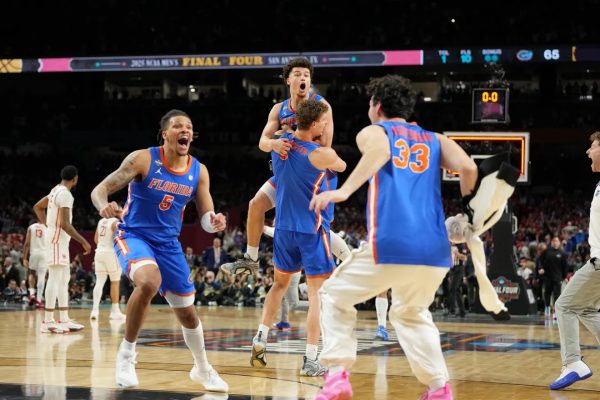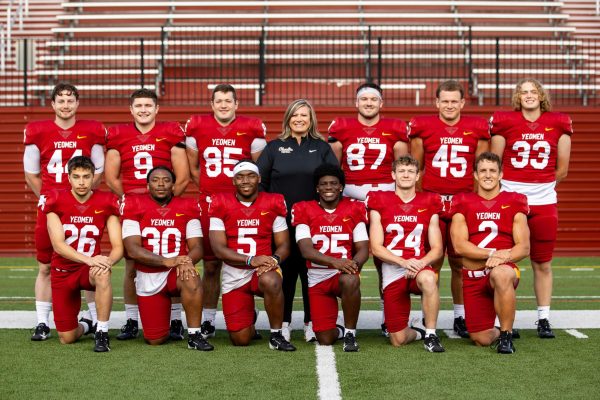Frisbee and Football: An Unlikely Love Story
Unlike what its name might suggest, the Oberlin Flying Horsecows Ultimate Frisbee team should be taken seriously.
According to USA Ultimate, its A team had a 25–12 record last year, sweeping the Ohio Valley Division III Regionals without a single loss and ending the season with a respectable 2–4 appearance at the Division III College Championships — colloquially known as Frisbee “nationals” — in Rockford, IL. Making it to the championships was noteworthy itself, but now the Flying Horsecows are hungrier than ever and hope to do it again. This time, they hope to finish with a higher position in the final standings.
“One of the reasons why we might not have done as well at nationals [last year] is … due to [the lack of ] fitness and speed and general physicality,” said double-degree junior Colin Cahill, one of the captains of the Flying Horsecows.
While practices, scrimmages, and team socials are typically all that’s required for club sports, the Flying Horsecows have taken their dedication to another level by enrolling in the ATHL 199 Advanced Conditioning course that meets at a grueling 8 a.m. on Tuesdays and Thursdays. This type of dedication is unsurprising: The team is currently ranked as the fifth best Division III Ultimate Frisbee team in the nation, according to Ultiworld, a premier online publication devoted to Ultimate Frisbee news and rankings, and USA Ultimate has named the Flying Horsecows as the best DIII Ultimate team in the entire state of Ohio.
“Our goal [this season] is to prove that [those] rankings are true,” Cahill said.
According to the Oberlin course catalog, ATHL 199 is designed to encourage participants to “learn how to increase their physical conditioning through the use of anaerobic exercises that cover all sub-contexts of conditioning including sprint work, speed training, agility exercises, plyometrics, and body weight exercises.” However, it’s widely assumed that the class is primarily designed to condition varsity football players in their offseason. This theory is partly supported in that the class is instructed by Head Football Coach Jay Anderson.
“For the past two years, there [have] been [a few non-football players] in this class, but they’ve always been the most motivated people,” Cahill explained. This year, the Frisbee players outnumber the football players by a wide margin, unlike the ratio in previous years.
According to Cahill, the ATHL 199 course has the reputation of being exhausting beyond belief and a test of the furthest extent of humankind’s physical capabilities. This might not be too far from the reality.
“Yeah, it’s kicking our butts,” he said.
There is a common perception that varsity athletes and non-varsity athletes rarely overlap within the Oberlin community, least of all within Philips gym in the context of working out together. In light of this, the ATHL 199 class roster is somewhat of a social and cultural enigma.
“The class is [technically] open to all students,” said College junior, varsity football player, and ATHL 199 student Von Wooding. “I think it’s a good thing that they come to work out with us.”
Moreover, the Flying Horescows have taken advantage of the freedom in club sports — compared to DIII varsity rules and regulations — and is open to all gender identities. While varsity sports make gender-inclusivity difficult to navigate due to the concrete delineation between men’s and women’s sports, the Oberlin Athletics Department itself has been working to make athletic opportunities and spaces more accessible with a larger variety of classes and environments introduced in with its new YeoFit program, which launched last fall.
“I can understand why anyone who is not a cis[-gender] man might not want to get involved with a class that is full of [many] large cisgender men who are going to be very good at the things that are in the class,” Cahill explained. “Sometimes going into a new situation, it can be an oppressive environment, but you can also look at it [another] way and say, ‘I have so much to learn.’ It can be a challenge.”
One shared interest between both the Ultimate Frisbee and football players in this class, though, is the desire to become better at their respective crafts. As acknowledged by both football and Flying Horsecows team members, the two groups have a good deal of commonality between them.
“[The class] is positive and productive,” Wooding said. “You get to interact with people you might not [otherwise] come across very often.”





